Moon viewing guide: What to look for on the lunar surface
Fancy taking a moonlit tour of our rocky companion?
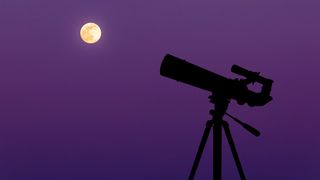
The moon is by far the most luminous object in the night sky.
Reaching a maximum brightness of -12.92 magnitude, it's hard to miss as it boldly takes center stage and washes out any celestial object that is unable to challenge its brightness.
Its unmistakable entrance is marked by lighting up the sky as a curved sliver of light— the waxing crescent — before revealing its entire face as the full moon. Despite its beauty, this chunk of rock that has accompanied our planet since its formation is something that many take for granted.
This is because it always seems to be there. We see it on a nightly basis and, with the naked eye, we are able to pick out the craters, volcanoes, ridges, and basins that plague its terrain. We suspect that we've seen all that our moon has to offer. But have we?
Related: Apollo landing sites: An observer's guide on how to spot them on the moon
If you've never pointed a pair of binoculars or a telescope at our satellite, then you'll be surprised to learn that the moon is an astronomical object worthy of observing in its own right. What's even better is that because it is the closest celestial body to us it is very easy to observe, even with the naked eye, and especially when some of its more obvious features are lit up by the sun.
To see the finer details of its battered surface, though, you'll need a pair of binoculars or a telescope; the greater your instrument's aperture, the better. The added beauty is that whatever phase of the moon is being revealed to Earth, it still has several features on show for you to find and observe.
If you're looking for a telescope or binoculars to observe the moon, our guides for the best binoculars deals and the best telescope deals now can help. Our best cameras for astrophotography and best lenses for astrophotography can also help you prepare to capture the next skywatching sight on your own.
There is something that our moon likes to keep relatively hidden from us — its far side; the face we never see. This is because our rocky companion spins on its axis at around the same time that it takes to orbit the Earth. Though it is not always entirely hidden, sometimes the interaction between the moon and Earth causes our satellite to rock backward and forwards in a motion known as libration, revealing about 9% more of its surface, and showing different halves at different times. Because of the angle of the Earth to the moon, you'd be hard-pressed to spot anything interesting on the moon's far side, but it is certainly worth looking out for.
Setting sail on the lunar seas
They are the first thing you are likely to spot when you gaze upon the moon's surface, making that pattern that we often refer to as the Man or Rabbit in the moon; the moon's seas or, as astronomers call them, lunar maria.
But unlike our planet, and what early stargazers thought, these are not vast bodies of water that we're used to, these are the plains of our companion's very active past; the mark of volcanic eruptions between some 3 and 3.5 billion years ago that spewed out lava, rapidly cooling to form stretches of grey basaltic rock.
These seas are also fairly dark and less reflective of the sun's light than the light grey areas that surround them — this is all down to the rich amounts of iron found in these lunar seas.
But it's not all great seas, if you look carefully enough, you can also spot some of the smaller lakes, marshes, and bays that litter the lunar surface. Most of these features can be seen when the moon is full or close to full and with the naked eye. However, if you find that you are struggling, then a good pair of binoculars will help you.
The mountainous moon
The lunar surface would not be complete without its ridges, valleys, and faults. It also would not be the rocky world we have come to know without the majestic mountains that rise out of its dry, dusty surface and team up to form gigantic mountain ranges stretching out anywhere from 31 to 491 miles (50 to 790 kilometers) in diameter.
Despite their monstrous sizes, you will need a telescope to get the full benefit of spotting these incredible landmarks. These are best viewed while the moon is in a transitional phase with its terminator visible.
Counting craters
Craters, craters, everywhere! Our moon shows signs of being incredibly scarred with the thousands of pockmarks and dents in its rocky surface — most of which have been formed by chunks of space rock smashing into it.
We know the moon to be a barren world — devoid of any water, atmosphere or tectonic plates. What this means is that there are no elements to wear these craters down and they're there to stay with some dating over two billion years old. What's more is that they come in a whole variety of brightnesses, sizes and depths; with some boasting raised rims and central peaks.
Some of the craters are so big that we can even see them from Earth with binoculars or using a telescope. And, as the moon shifts through its phases, you can watch the variation in lighting alter their features, making them all the more exciting to watch.
Swipe through our gallery below to see our top eight craters and their coordinates to help you locate them on the lunar surface.

Plato
Coordinates: 51.6 degrees north, 9.3 degrees west
Diameter: 68 miles (109 km)
Depth: 0.6 miles (1 km)

Copernicus
Coordinates: 9.7 degrees north, 20 degrees west
Diameter: 58 miles (93 km)
Depth: 2.4 miles (3.8 km)

Manilius
Coordinates: 14.5 degrees north, 9.1 degrees east
Diameter: 24 miles (39 km)
Depth: 2 miles (3.1 km)

Stevinus
Coordinates: 32.5 degrees south, 54.2 degrees east
Diameter: 47 miles (75 km)
Depth: 1.9 miles (3 km)

Tycho
Coordinates: 43.31 degrees south, 11.36 degrees west
Diameter: 54 miles (86 km)
Depth: 3 miles (4.8 km)

Aristarchus
Coordinates: 23.7 degrees north, 47.4 degrees west
Diameter: 25 miles (40 km)
Depth: 2.3miles (3.7 km)

Kepler
Coordinates: 8.1 degrees north, 38.0 degrees west
Diameter: 20 miles (32 km)
Depth: 1.6 miles (2.6 km)

Langrenus
Coordinates: 8.9 degrees south, 60.9 degrees east
Diameter: 82 miles (132 km)
Depth: 1.7 miles (2.7 km)
More targets to look out for
Phases of the moon
As the moon orbits our planet every 27.3 days, the trick of the sunlight gives us a run of phases roughly every 30 days.
Related: What is the moon phase today? Lunar phases 2022
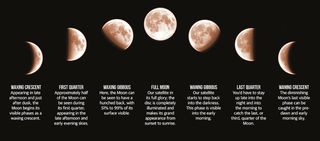
In Earth's shadow: Lunar eclipses
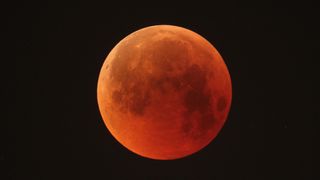
When the moon turns crimson, we know that our lunar companion has passed into Earth's shadow — the umbra — where no direct sunlight, other than that which filters through our planet's atmosphere, can reach its surface.
When this happens, we are experiencing a lunar eclipse. Unlike solar eclipses, the beauty of the lunar version is that, provided you're on the night side of Earth, you'll get to see this event wherever you are.
As an added bonus, you don't need protective eyewear, or even optical aids, to watch a lunar eclipse, whether it's a total or partial one.
Earthshine
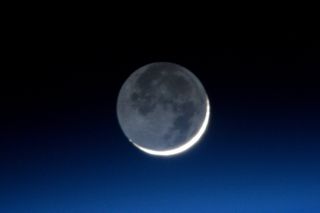
When the moon begins its phases for the month as a waxing crescent before it transitions into its first quarter, you might have noticed that you can just about make out the rest of the lunar surface — and some of the seas that dominate its rocky face — even though it is still in shadow.
The brightest segment of the moon visible to us is basking in the scorching hot rays of the sun, so what is causing the rest of the moon to glow when it is not due to reveal itself to us yet?
Light rays get wherever they can and what’s happening is that the sunlight that's reflected from Earth is being transferred onto the moon's face. This is called Earthshine, and it is usually most readily observable during the waxing and waning crescent phases.
Join our Space Forums to keep talking space on the latest missions, night sky and more! And if you have a news tip, correction or comment, let us know at: community@space.com.
Get the Space.com Newsletter
Breaking space news, the latest updates on rocket launches, skywatching events and more!
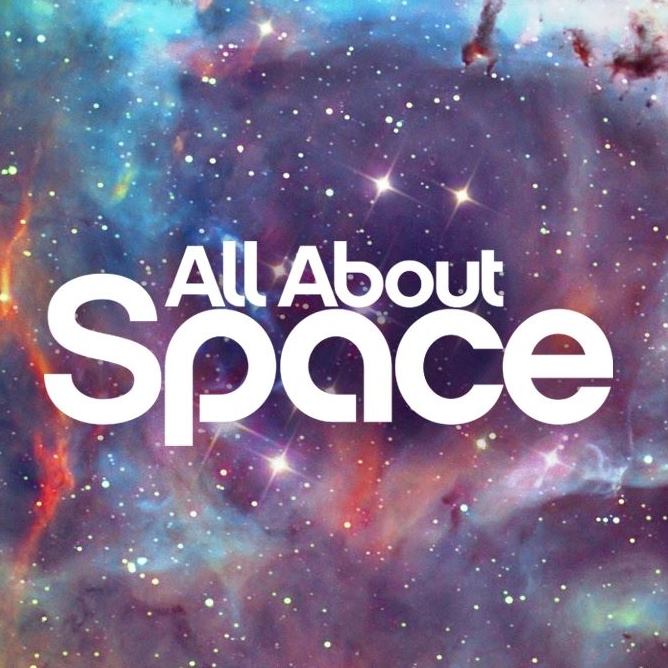
All About Space is where stunning images combine with accessible and authoritative text to educate and inspire readers of all ages while taking them on a spectacular journey through the Solar System to the known limits of the universe. Characterized by quality and accessibility All About Space is a brand dedicated to delivering expert commentary on the latest cutting-edge research, technology and theories in an entertaining and visually stunning way.
Get fantastic offers by subscribing to the digital and/or print edition now. Subscribers get 13 issues per year!
- Daisy DobrijevicReference Editor